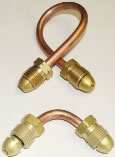Propane Regulator Connection - Pigtail
The connection between the propane tank and regulator is commonly called the pigtail or hogtail. The pigtail connects to the service valve of the propane tank and the inlet connection of the regulator. This connection is relatively small in diameter which initially restricts the flow of gas from the tank to the regulator. Pigtails must be replaced when the regulator is replaced.
Propane Regulators and Flexible Connectors
The NFPA defines the regulator connection (pigtail) between the tank and regulator as a flexible connector. Flexible connectors must be 36 inches or less, meaning the regulator will be installed no more than 36 inches away from the service valve. The primary reason for this 36 inch maximum length is protection against tank pressure being delivered to the downstream piping in the event of a leak. If there is a leak in the system, the regulator acts as a protective device and will not allow the full LP Gas vapor pressure of the tank to reach downstream. Pigtails also function as protective measure against movement in the gas line. They are "flexible" and will absorb the shock of sudden movement or jarring of the gas service line if it is accidentally bumped or moved out of place. Without the flexible regulator connection, the piping would be rigid and more susceptible to leaks forming in the event the piping, tank, or service line moves, either gradually or suddenly.


Propane regulator connections are available in varying lengths and bends. Although many of the pigtails installed are straight to begin with, the installing gas technician bends the connector in order to ensure that the regulator easily fits underneath the tank dome. Pigtails that are bent during fabrication are primarily used where space (lack of) is an issue, such as in an underground tank installation. The regulator connections pictured to the left are 90 degree bend pigtails. Notice that the longer bent pigtail actually allows the regulator to be installed closer to the service valve.
Because pigtails can can catch or trap debris from the propane tank over time, they should be replaced any time the regulator is replaced.
